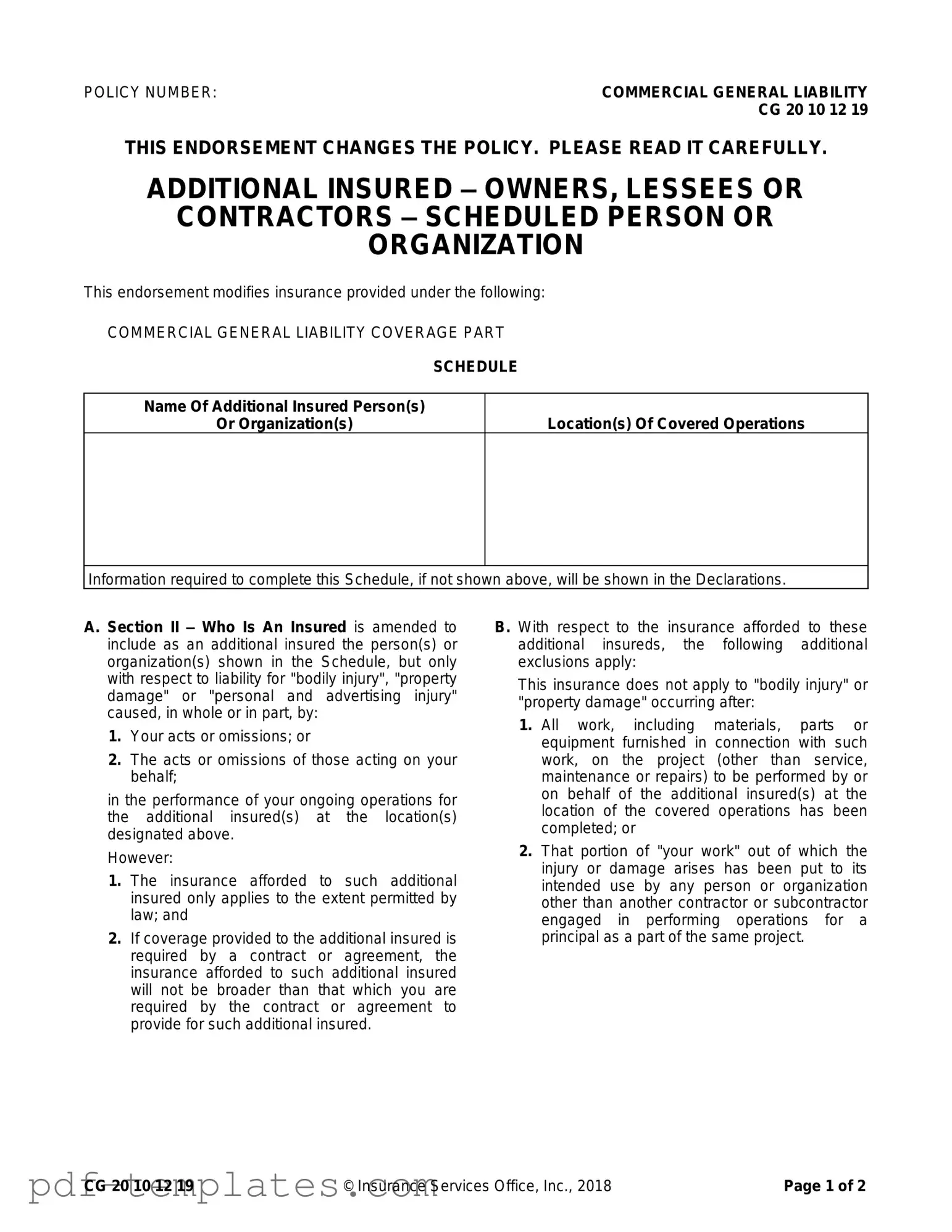The CG 20 10 07 04 Liability Endorsement form is similar to the Additional Insured Endorsement (CG 20 10). This form allows a policyholder to add another party as an additional insured under their general liability policy. Like the CG 20 10 07 04, it provides coverage for bodily injury, property damage, and personal and advertising injury caused by the policyholder's actions or those acting on their behalf. The primary difference lies in the specific limitations and exclusions that may apply, which can vary based on the circumstances of the coverage.
The CG 20 37 form, known as the Additional Insured - Owners, Lessees, or Contractors form, is also comparable. It provides similar coverage to that of the CG 20 10 07 04 but is specifically tailored for contractors and property owners. This form ensures that both parties are protected in case of claims arising from the contractor's work. The key similarity is the provision of additional insured status, while the differences may include specific language related to the types of operations covered.
Understanding various insurance endorsements, including the CG 20 10 07 04, is crucial for businesses operating in California, especially when dealing with liability coverage. To ensure compliance and proper documentation, it's important to familiarize yourself with necessary forms, such as the All California Forms, which provide essential resources for effective business practices in the state.
The CG 20 11 form, which is the Additional Insured - Managers or Lessors of Premises, shares similarities with the CG 20 10 07 04 in that it extends coverage to managers or lessors of premises. This endorsement protects those who manage or lease property from liability claims related to the insured's operations. Both forms address the need for additional insured status, but the CG 20 11 focuses more on premises-related risks.
The CG 20 33 form, titled Additional Insured - Construction Project, is another relevant document. It provides coverage for additional insureds specifically involved in construction projects. Like the CG 20 10 07 04, it addresses liability for bodily injury and property damage. However, it is tailored to the unique risks associated with construction activities, making it distinct in its application while maintaining similar coverage principles.
The CG 20 18 form, known as the Additional Insured - Blanket form, offers a broader scope of coverage. It allows for multiple additional insureds to be covered under a single endorsement. This is similar to the CG 20 10 07 04 in that it provides liability coverage for third parties. However, the blanket nature of this endorsement makes it particularly useful for businesses that frequently engage with various clients or projects.
The CG 24 04 form, titled Additional Insured - Vendors, is also comparable. It extends coverage to vendors who sell products or services related to the insured's operations. Like the CG 20 10 07 04, it protects against liability claims. The main difference lies in the specific relationship and types of claims covered, with the CG 24 04 focusing on vendor-related activities.
The CG 20 09 form, known as the Additional Insured - Joint Venture, is another similar document. It provides coverage for additional insureds who are part of a joint venture with the policyholder. This endorsement ensures that all parties involved in the joint venture are protected against liability claims, similar to the coverage provided in the CG 20 10 07 04. However, it specifically addresses the nuances of joint venture relationships.
The CG 20 36 form, titled Additional Insured - State or Political Subdivision, is also relevant. This endorsement extends coverage to state or political subdivisions when they are involved in a contract with the insured. Like the CG 20 10 07 04, it provides liability protection, but it is tailored to the unique requirements of governmental entities, making it distinct in its application.
The CG 20 14 form, known as the Additional Insured - Real Estate Management, offers similar coverage for real estate management companies. It provides protection against liability claims that may arise from the insured's operations. While both forms serve to add additional insureds, the CG 20 14 is specifically designed for real estate management scenarios, making it different in focus.
Finally, the CG 20 08 form, titled Additional Insured - Contractors, is comparable as well. This endorsement specifically covers contractors who work on behalf of the insured. Like the CG 20 10 07 04, it provides coverage for liability claims related to bodily injury and property damage. The distinction lies in its focus on contractor relationships and the specific terms that may apply to those situations.
